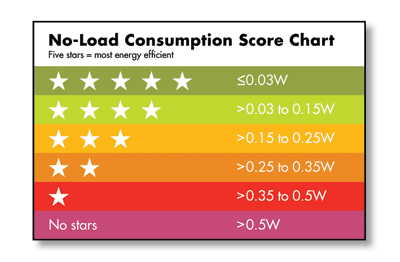Meeting 30 mW standby in mobile phone chargers
Achieving a five-star energy rating without secondary-side control
BY JAMES SHEEN
Fairchild Semiconductor
Taipei, Taiwan, ROC
http://www.fairchildsemi.com
Do the math and it’s easy to understand why government bodies and handset manufacturers are suddenly so smitten with reducing standby power in mobile phone chargers: There are over four billion mobile phone users worldwide and most of them leave their chargers plugged-in even when the phone is disconnected. According to Nokia, up to two-thirds of the electricity consumed by a mobile device is lost when in no-load mode.
While cutting greenhouse emissions and fossil fuel consumption is without question important to all of us, mobile phone charger solutions must also provide practical benefits such as reasonable cost, ease of implementation and assured reliability. Engineers look to designs with integration and packaging that combines a PWM controller, a MOSFET (if so desired) and protection functions into a single entity that enables a five-star energy rating with no-load power consumption of 30 mW or less. The industry average is about 300 mW, no load.
Stringent no-load tolerances
Today’s mobile phone consumers demand large touchscreens, a multi-megapixel camera, Bluetooth, and 802.11 Wi-Fi, Web browsing, e-mail and database access, GPS navigation, music and video downloads and, in the near future, mobile digital TV. All of these in-demand functions require power. Of course, the most common charging source is the ac wall outlet and an outboard ac/dc adapter, commonly referred to as a cell phone charger, although most of the time the charging circuit is actually located inside the mobile phone.
Mobile phones only require, on average, about 2 W when charging, while by comparison, laptop PCs need close to 100 W. Still, with over four billion mobile phone users worldwide compared to the one billion who own PCs reducing the power consumed by the chargers in standby, or no-load, has become one of today’s critical design considerations.
Measures have been taken to tighten requirements for both efficiency and no-load power. The most recent, and most stringent, of these is a voluntary charger Star Rating System agreement put forth by the world’s five largest mobile phone makers, Nokia, Samsung, Sony Ericsson, Motorola and LG Electronics. Chargers will be labeled starting at zero stars for >0.5 W standby power consumption and going up to the top five star rating for consumption of figure ). Most current mobile phones currently have standby power in the range of 150 to 300 mW.

The rating system for chargers goes up to five-stars at 30 mw idle power.
This is important so it bears repeating: To achieve the coveted five-star rating chargers must reach a level of no-load power consumption of 30 mW or less, which is 90% below the threshold of Energy Star level V.
Why tight CV/CC tolerances are important
Li-ion technology is currently the battery technology of choice for small portable devices. It is attractive because of its high energy density, low self-discharge characteristics, and tremendous flexibility in size and shape. Li-ion cells are generally suited to a constant-current/constant-voltage (CC/CV) charging strategy and the length of each charging mode depends on the capability of the charger.
The charger operates in a constant current charging mode when the battery voltage is low and this is when most of the energy is transferred. Once the battery has charged to the float voltage (battery voltage at zero current, usually around 4.2 V) the system will begin to reduce the charging current to maintain the desired voltage — and thus switch to constant-voltage mode.
Although relatively simple to implement, charging the cell actually requires precise control of the float voltage region to obtain to maximize battery capacity and improving service life. Imprecise battery voltage regulation could undercharge the battery, with a large decrease in battery capacity. Or, if the voltage is too high, the battery cycle life is significantly degraded. Excessive overcharging of a Li-ion cell could also result in catastrophic failure of the unit.
Meeting the 30-mW goal
For design engineers the bar has been raised suddenly. Consider that it was little more than a year ago when mobile phone power suppliers would receive kudos for designing CC/CV adapter/chargers with standby-mode consumption of 75 mW at 120 Vac and 90 mW at 240 Vac.
However, while 30 mW is a very challenging specification, it can be meet quite comfortably with the latest generation of primary-side-regulation PWM ICs. For example, Fairchild has the FSEZ1317 that integrates a 700-V, 1-A power MOSFET — providing big space and cost savings. CV/CC control tolerances have been tightened from ±10% to ±5% and the number of external resistors and capacitors needed has been reduced from 12 down to five (three resistors, two capacitors).
This primary-side-regulation PWM controller’s very precise CC/CV regulation is done without using secondary-side voltage or current-feedback circuitry needed in alternative solutions. Secondary-feedback circuitry in battery charger applications no longer appeals to designers since it increases cost, device count, and board space. It also negatively impacts energy efficiency, since secondary-side components consume power.
For designs that require an external MOSFET, an additional option available to engineers is something like the Fairchild FAN103 primary-side-regulation PWM controller. These low-cost ICs feature HV startup, proprietary Green Mode control, and a proprietary technique called Truecurrent, which regulates output current by using a primary-side-regulation-controlled flyback converter. The controller uses an analog signal process and sampling technology to achieve output voltage/current regulation through a primary-side auxiliary transformer winding. With this approach, a charger can achieve a smaller form factor, lower standby power, and higher efficiency than conventional circuit designs. ■
Advertisement
Learn more about Fairchild Semiconductor





